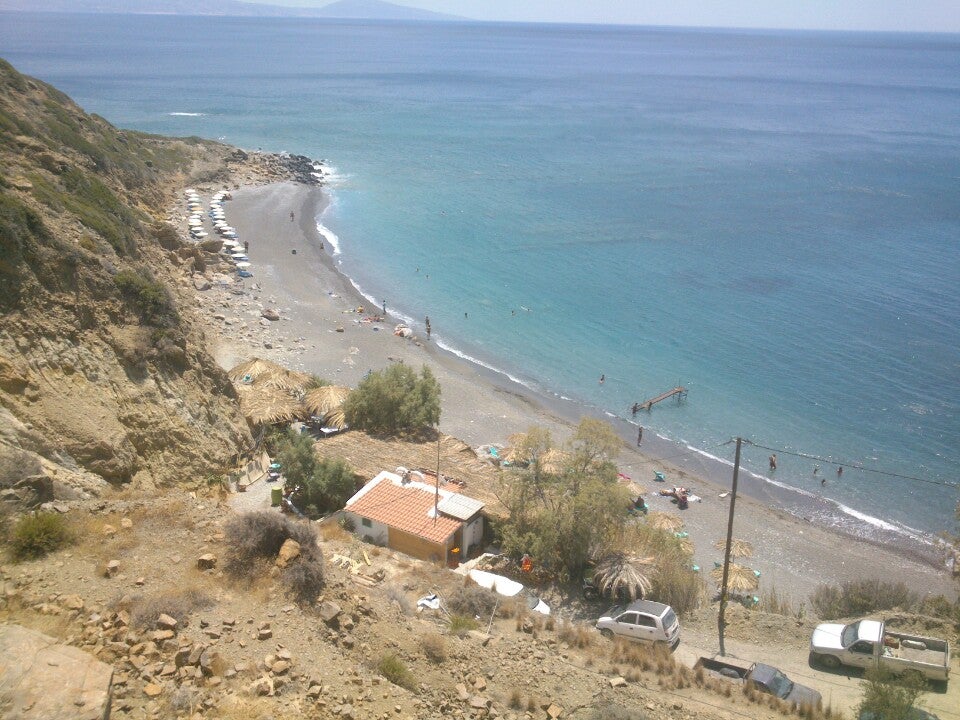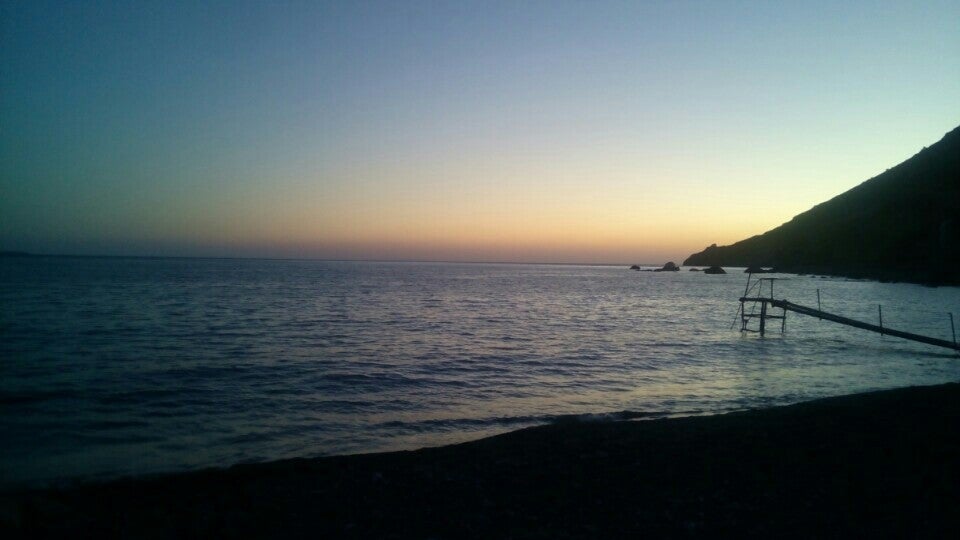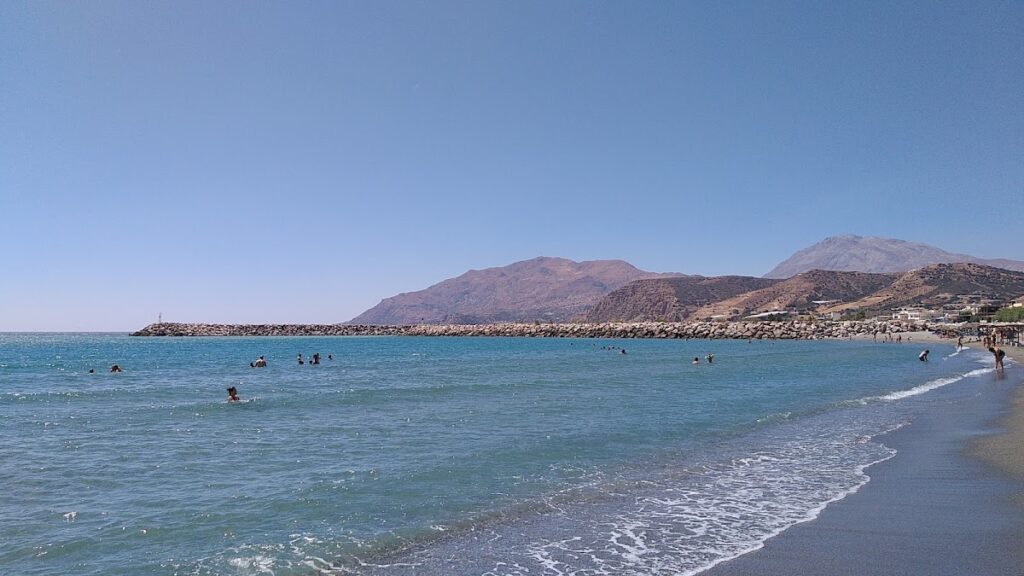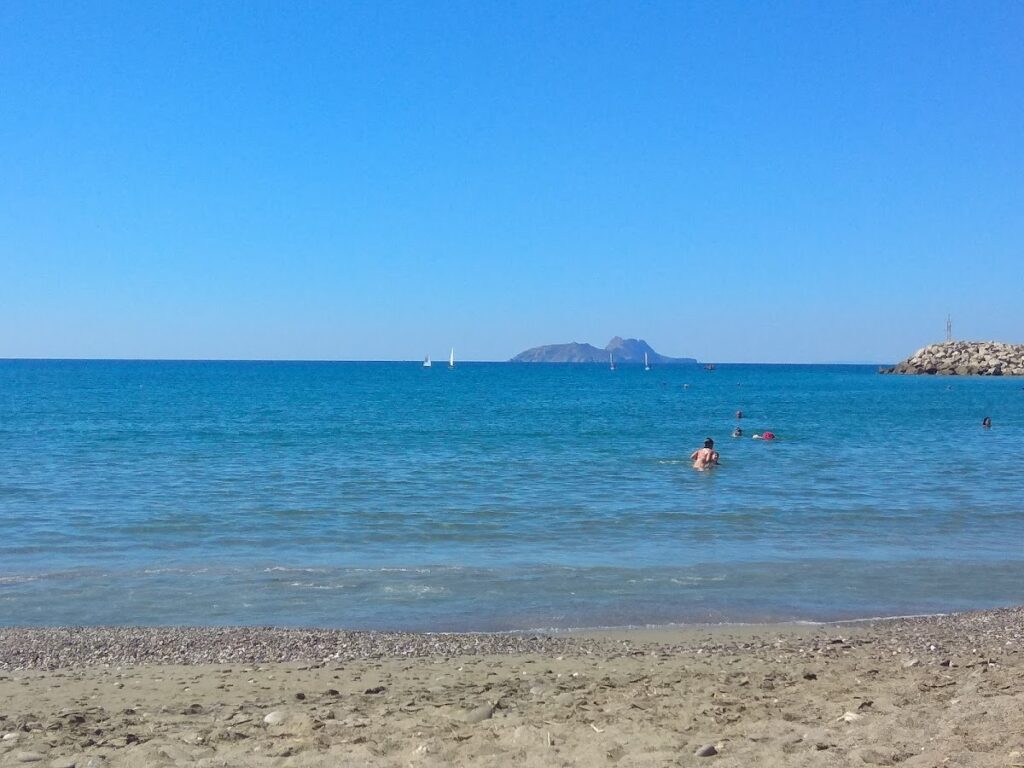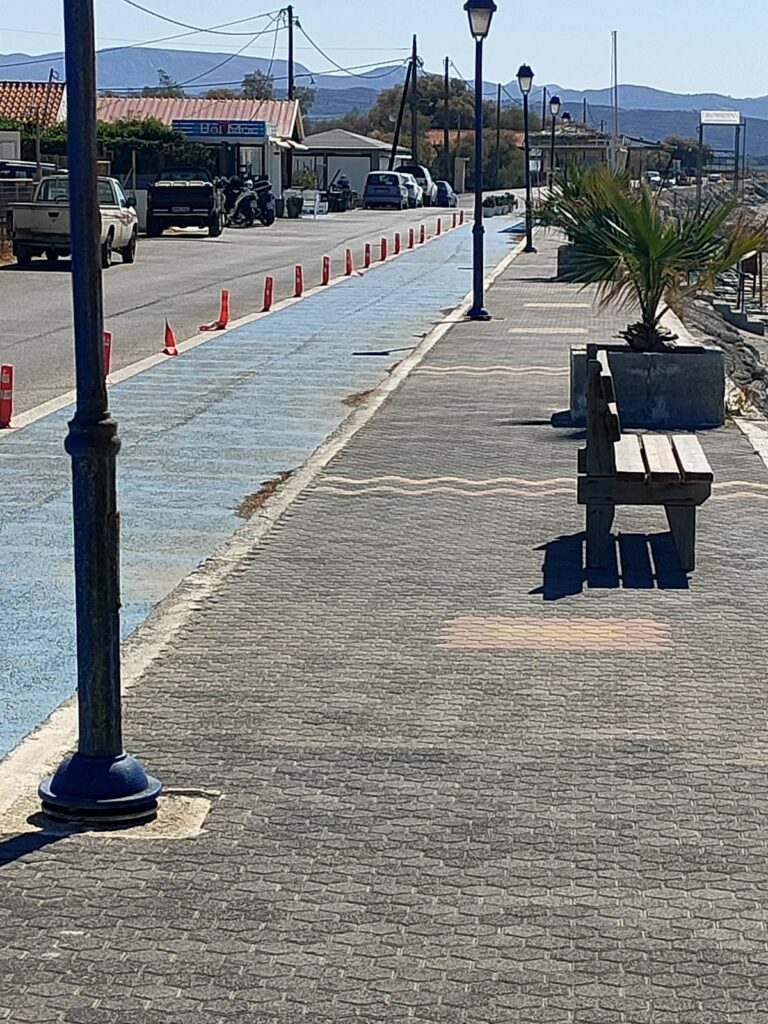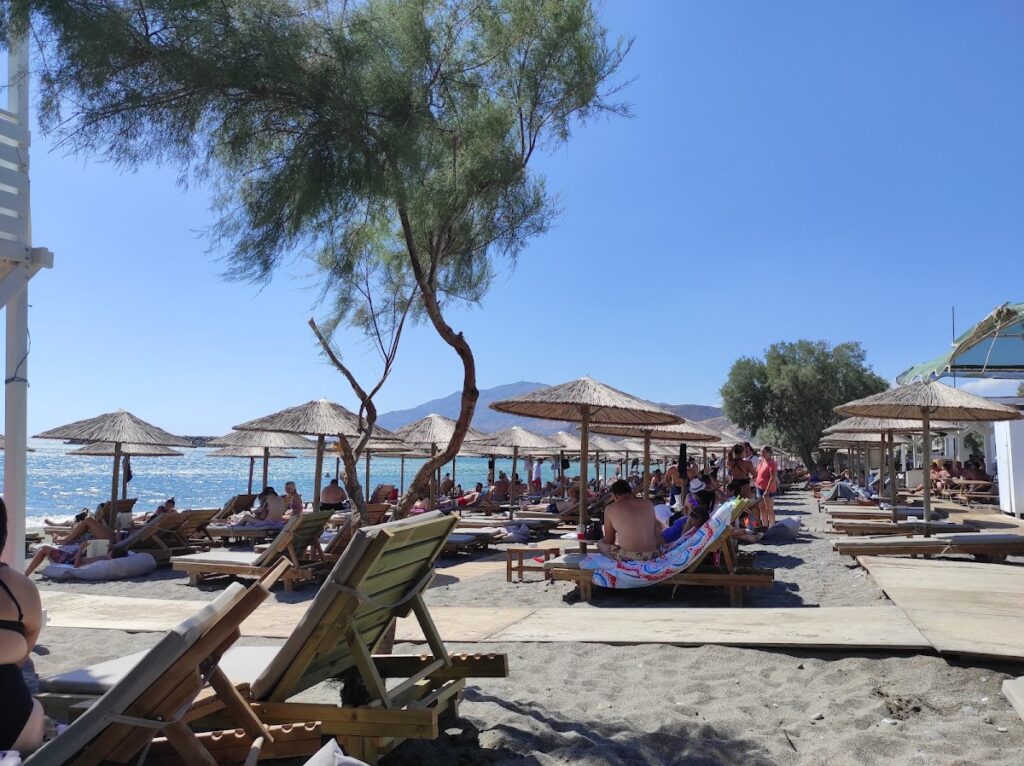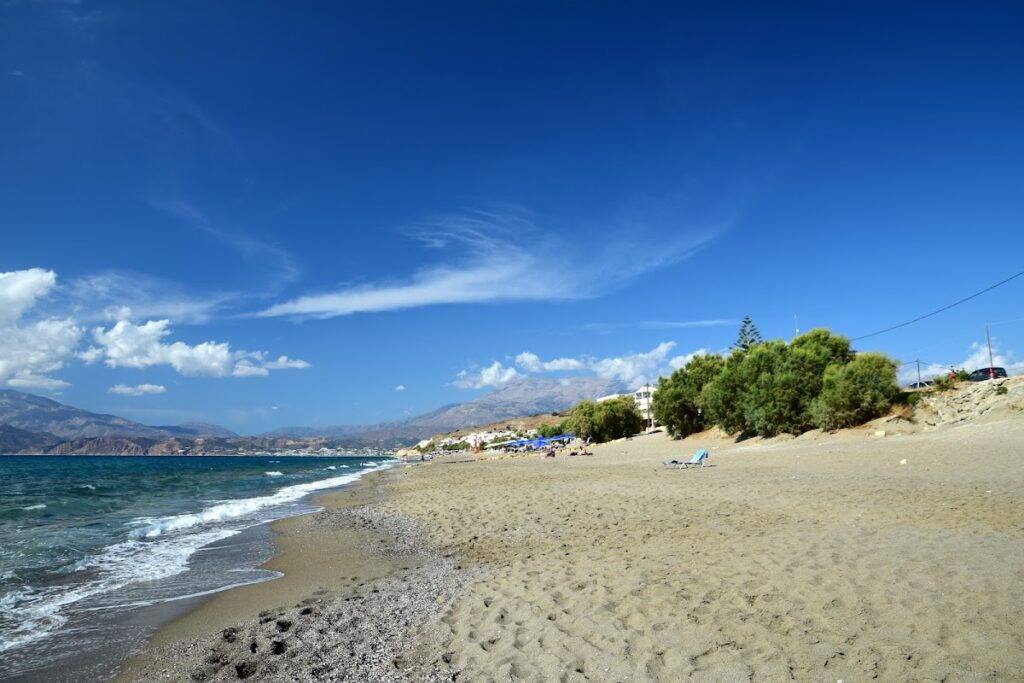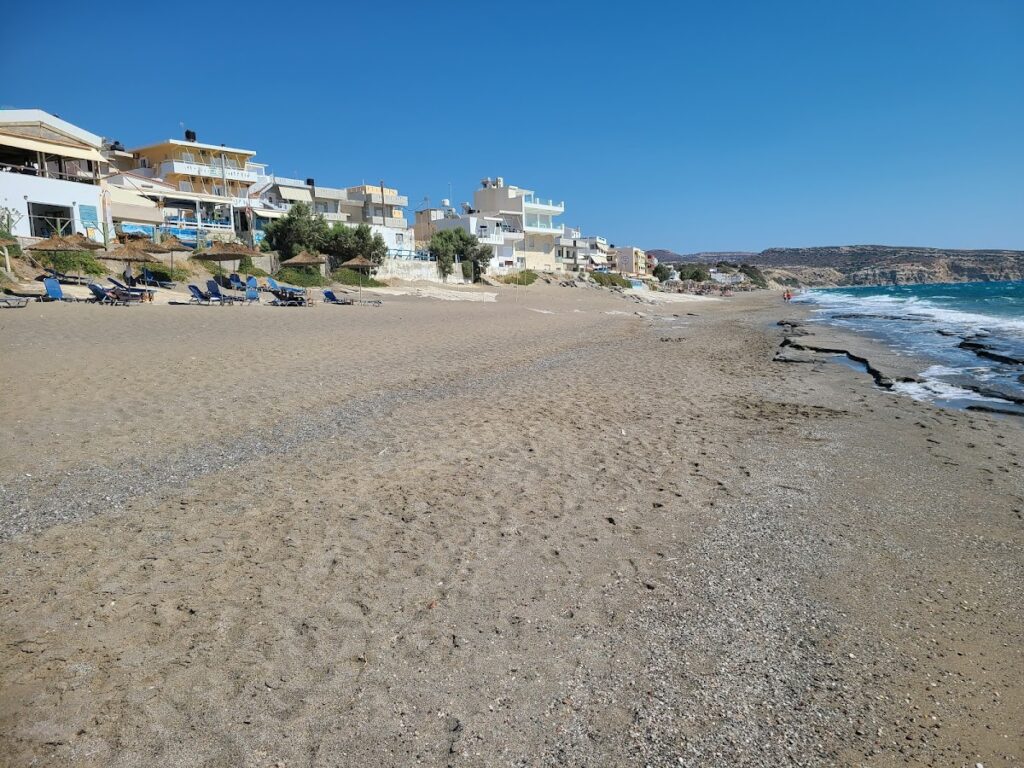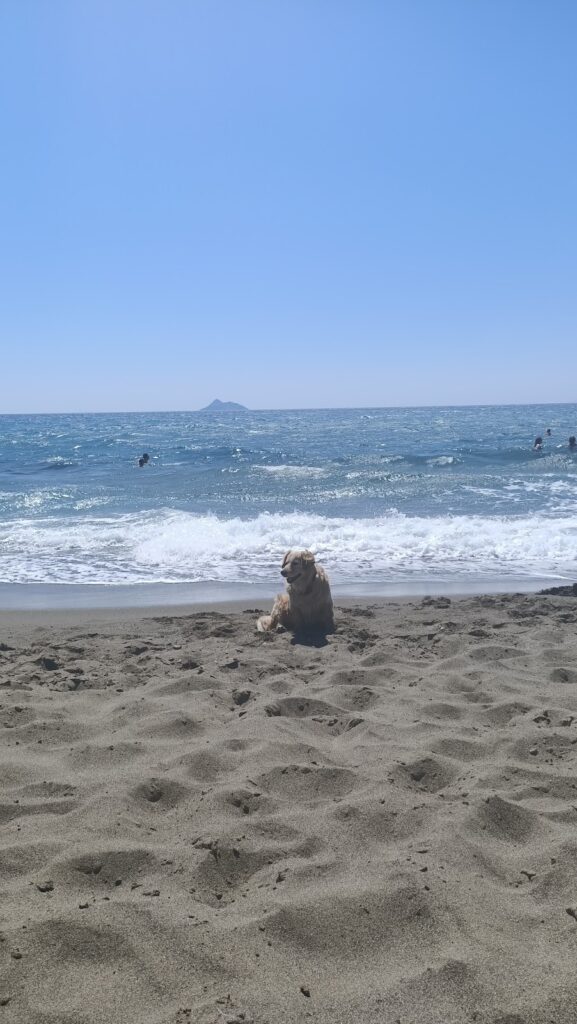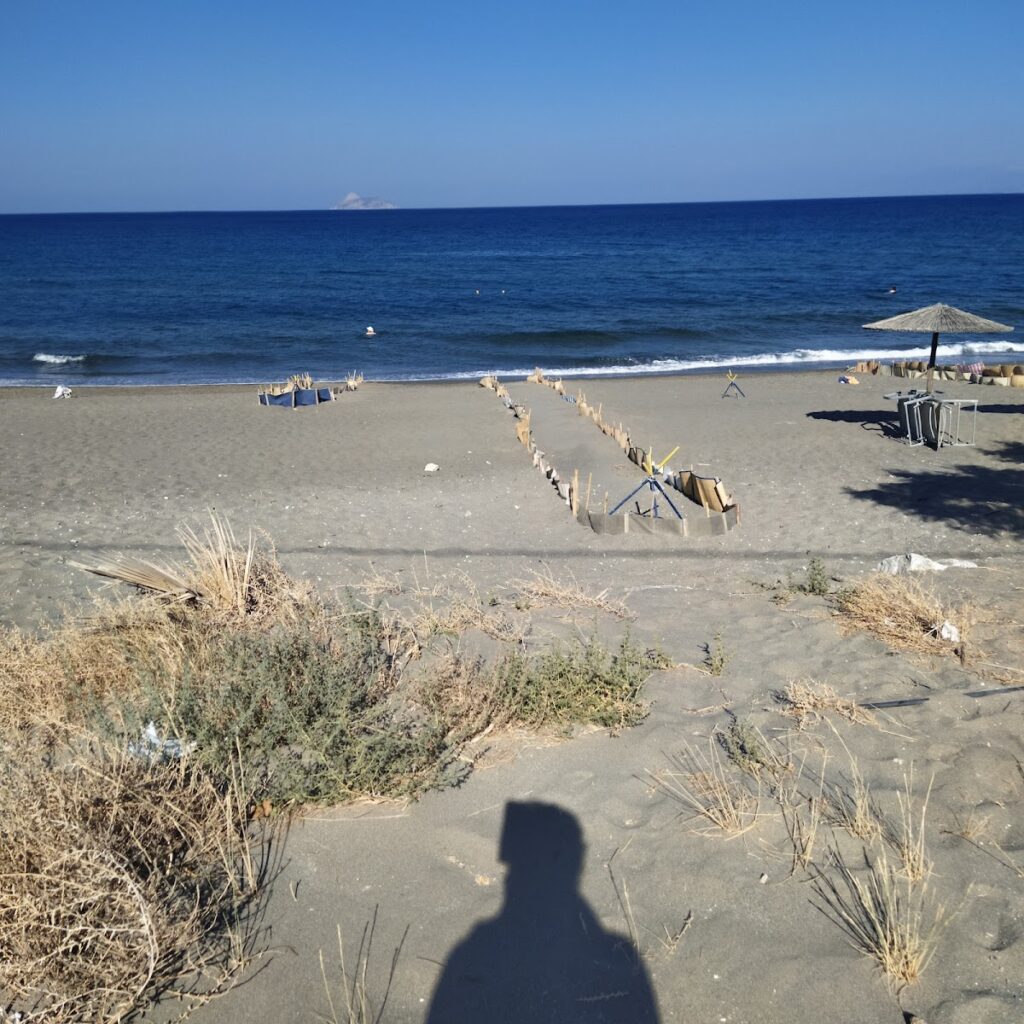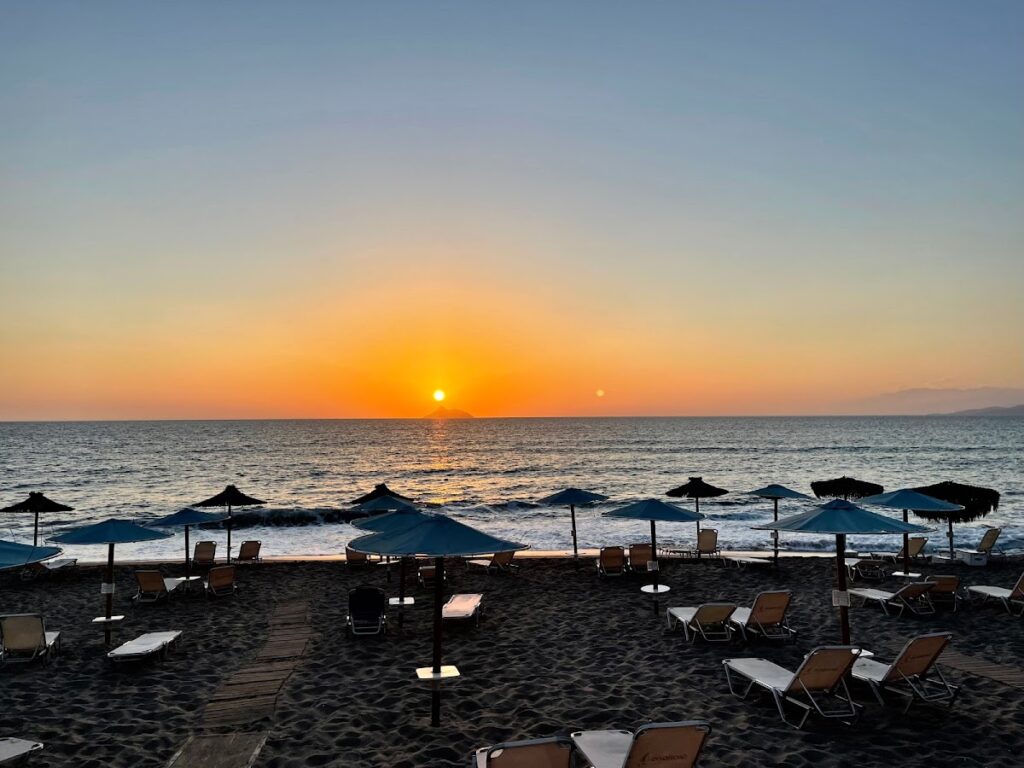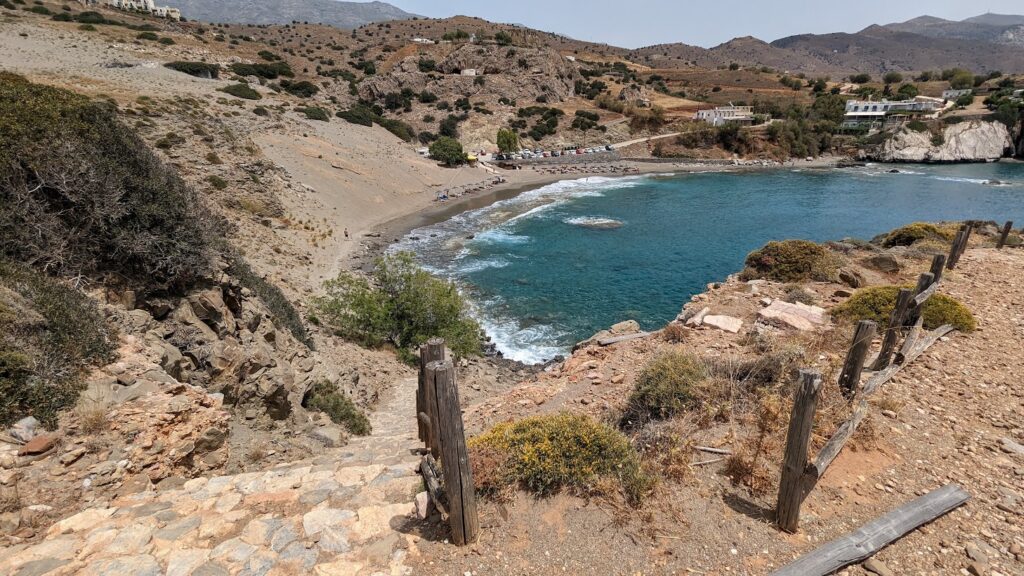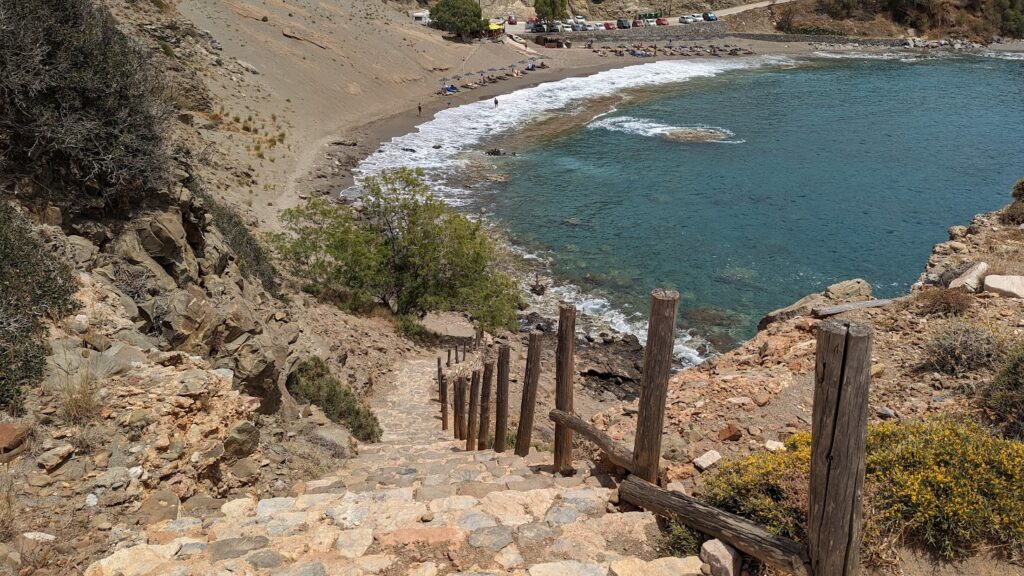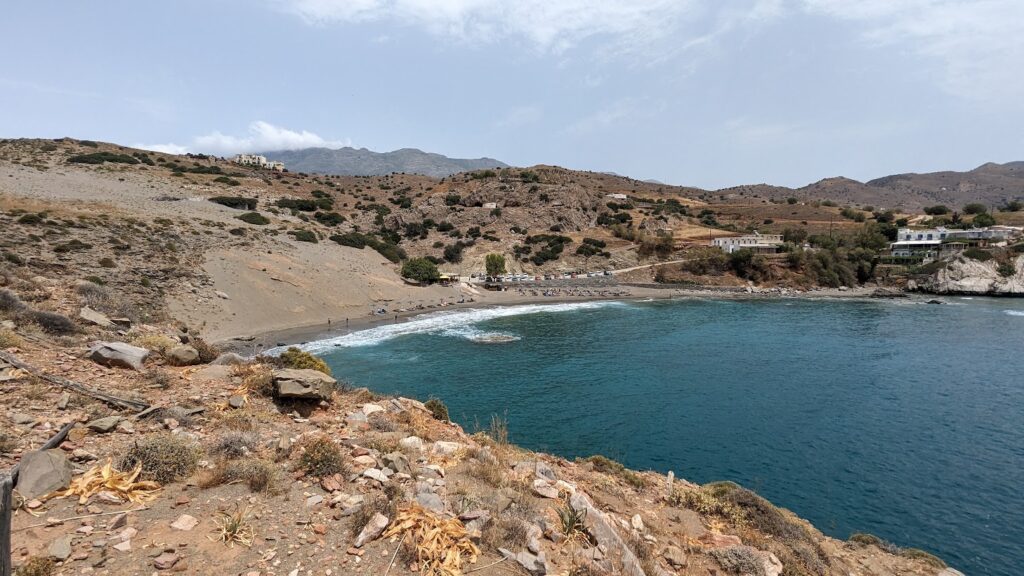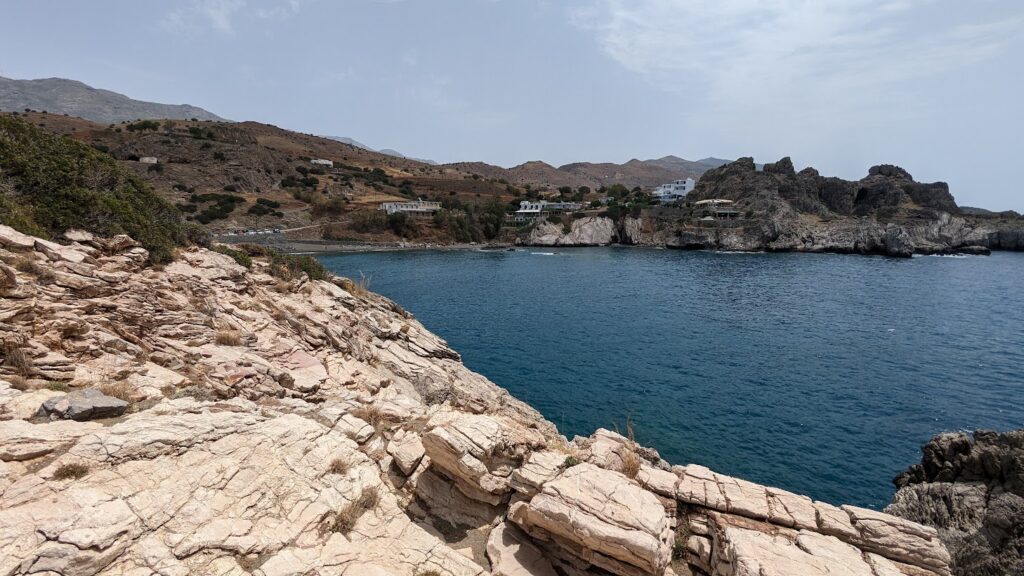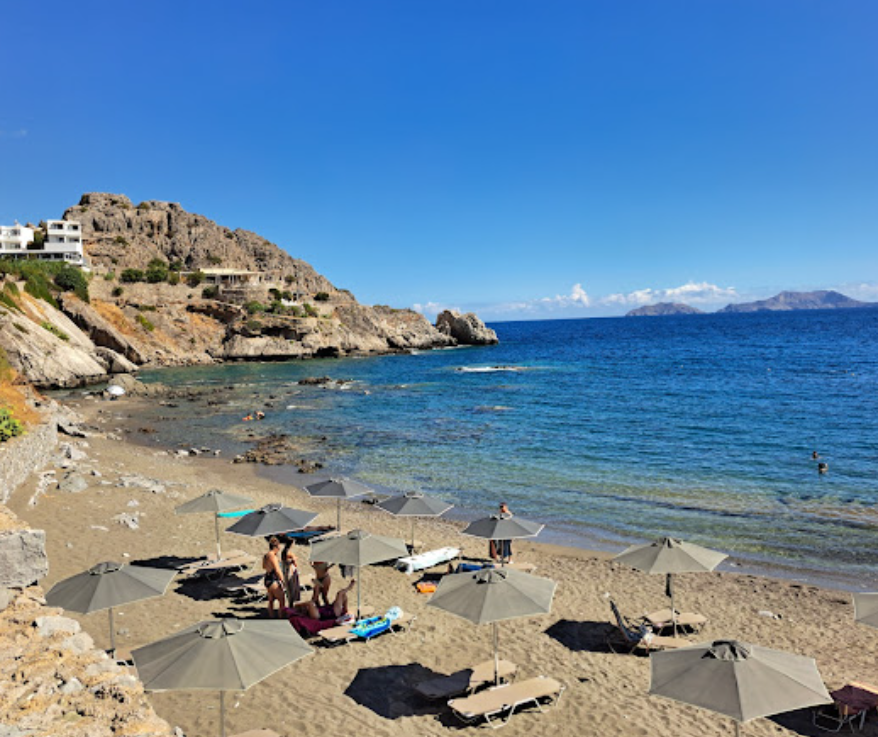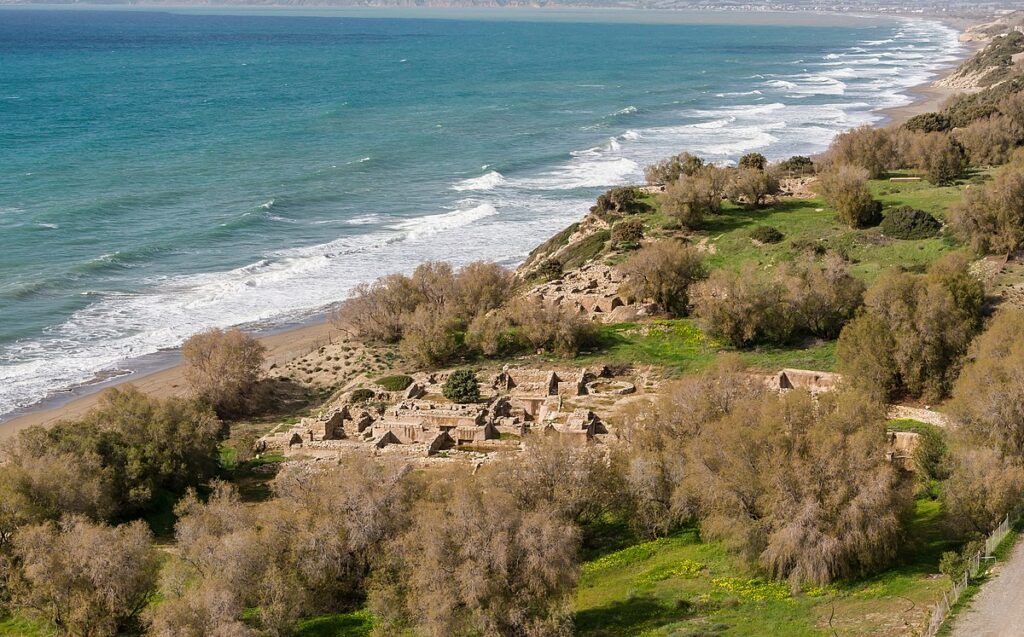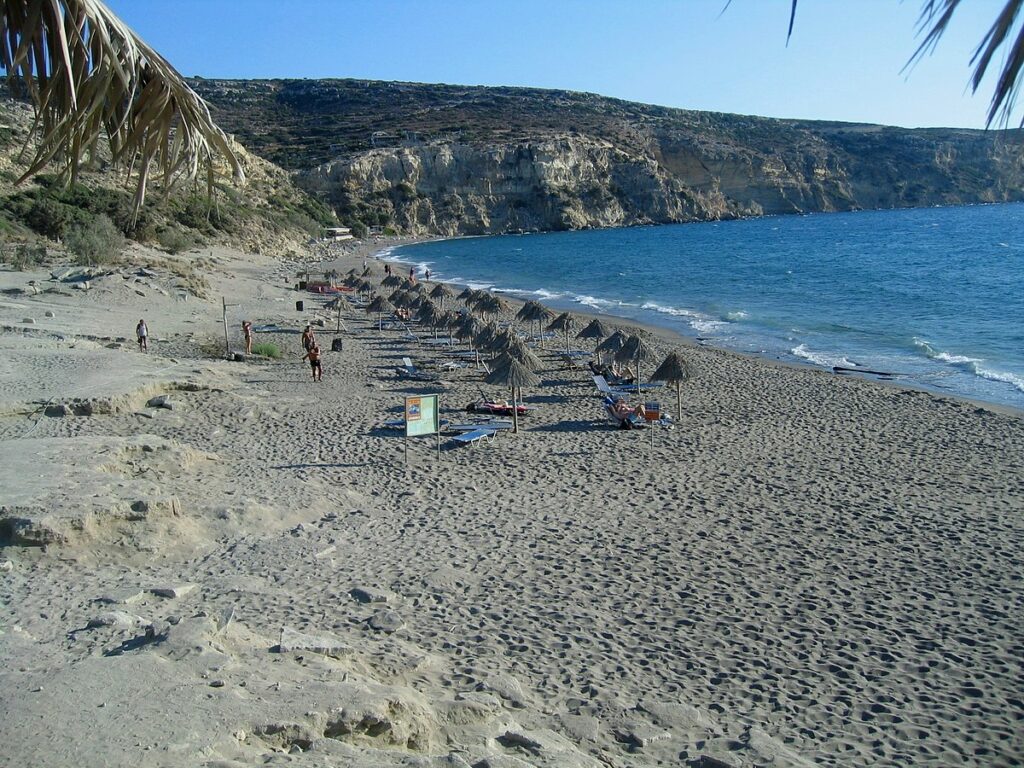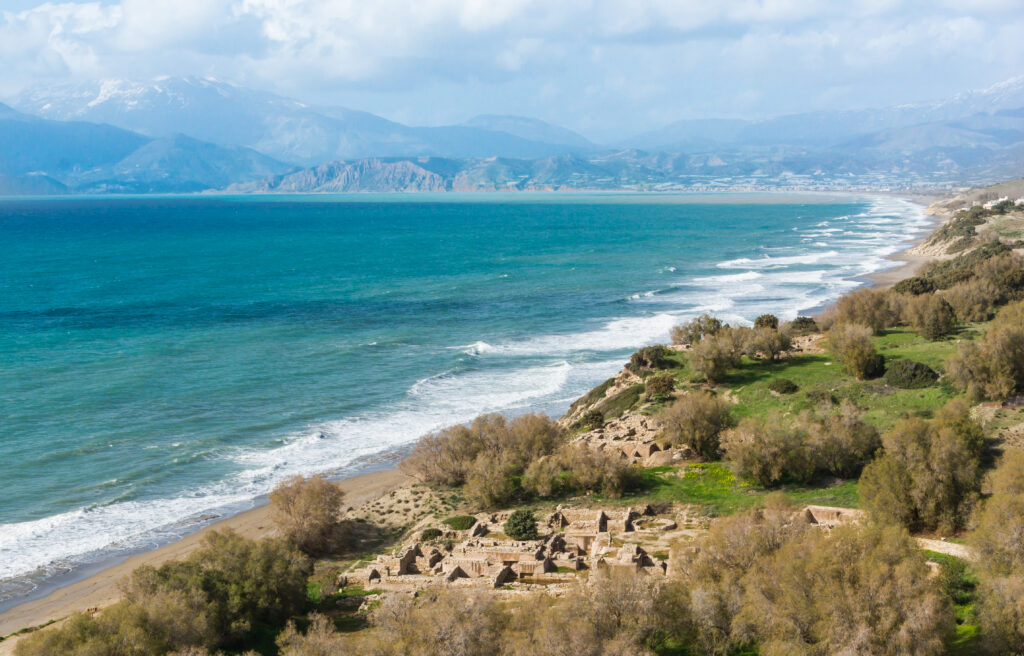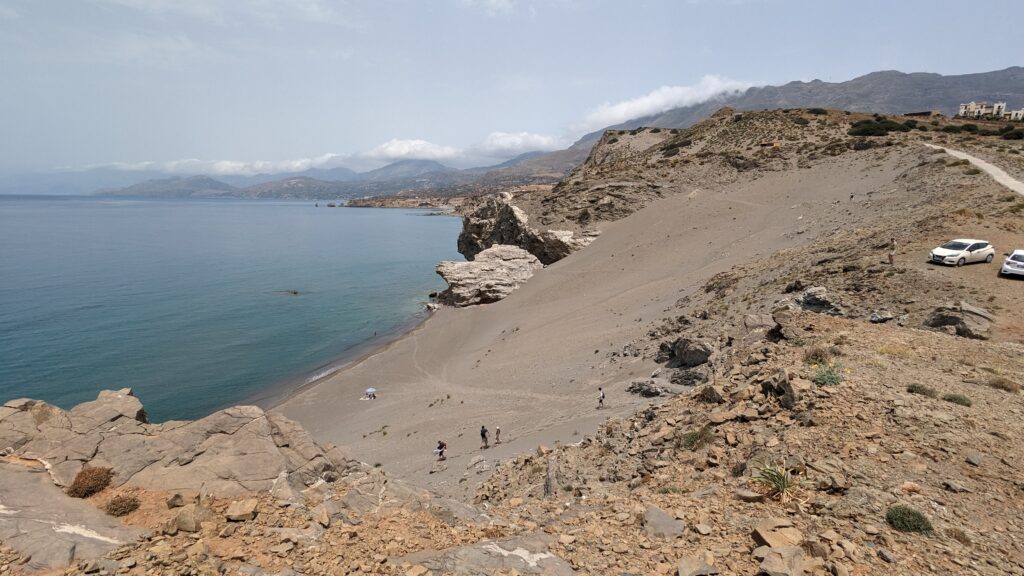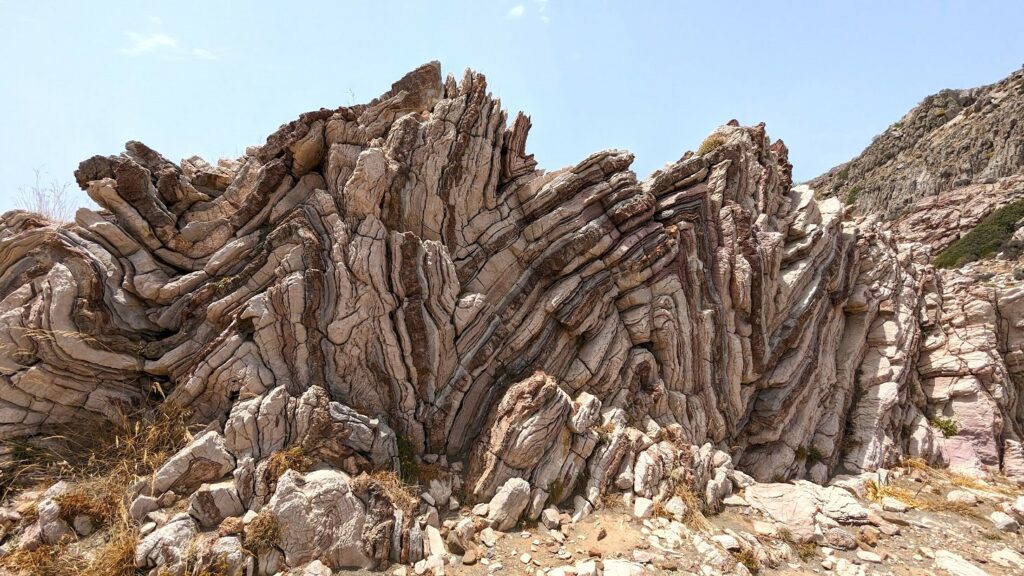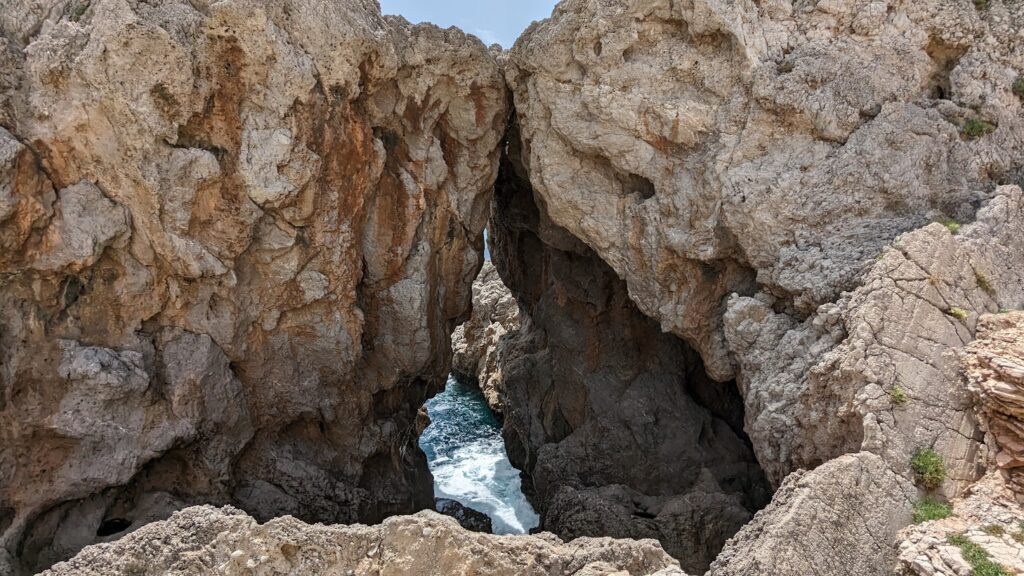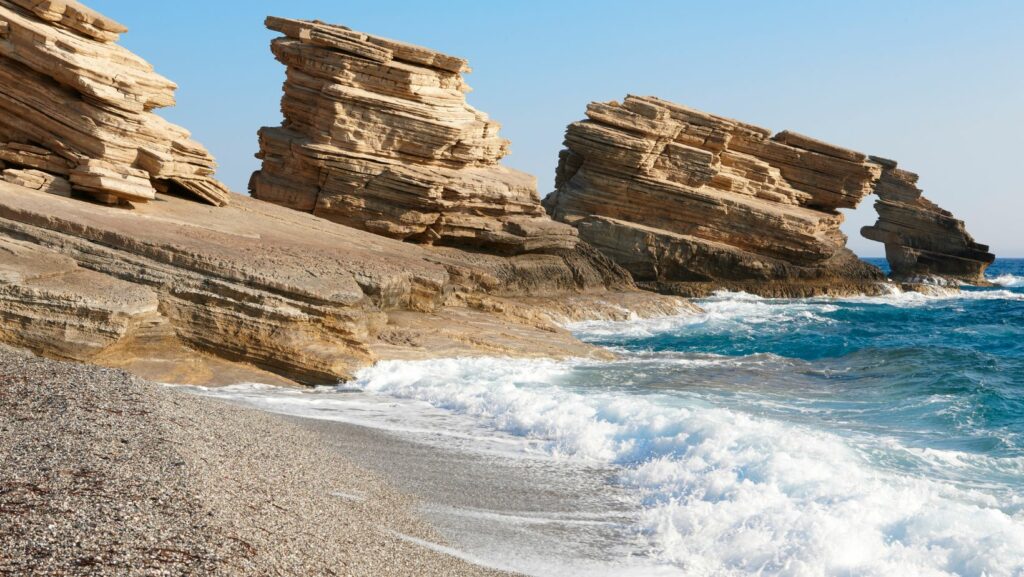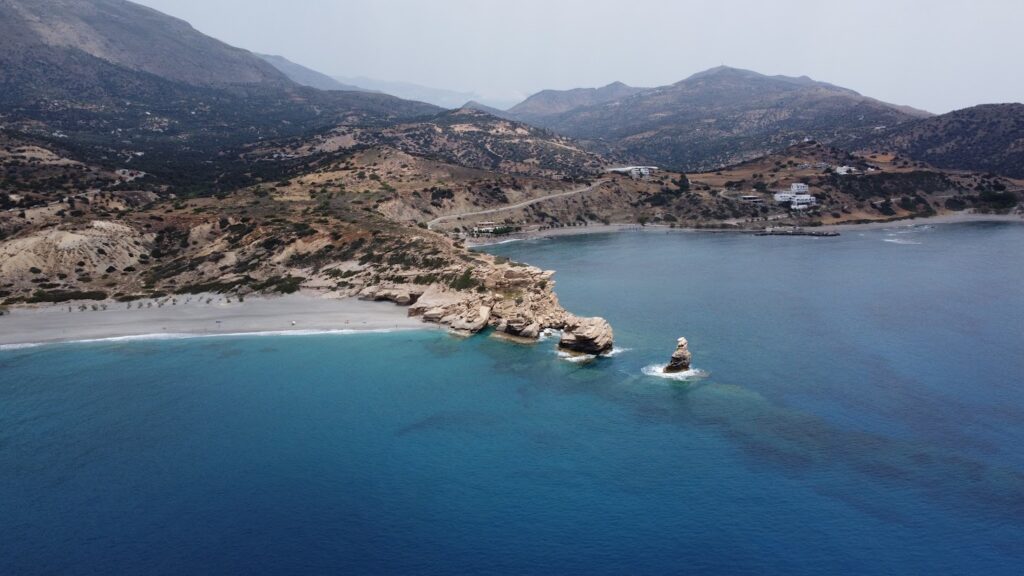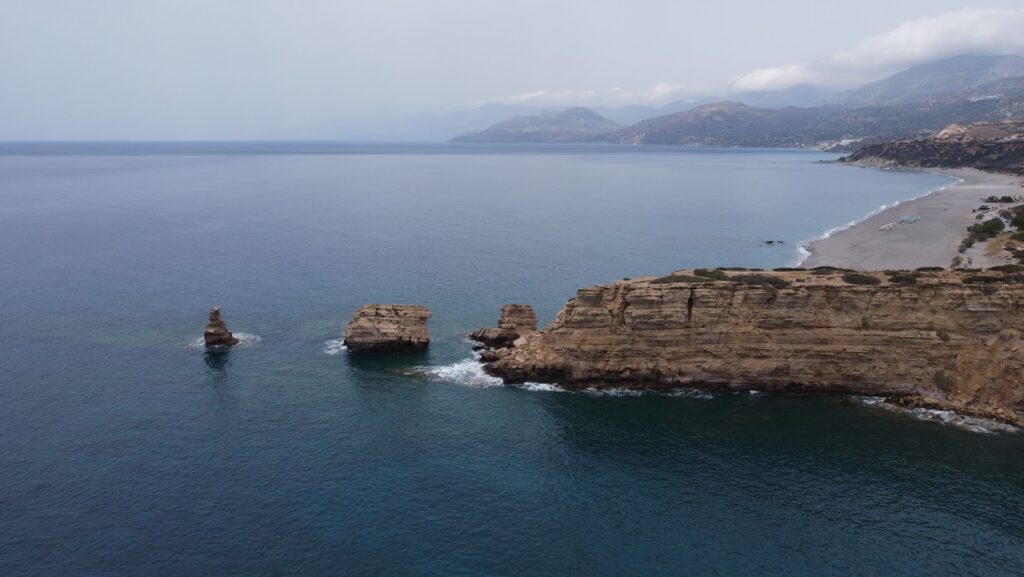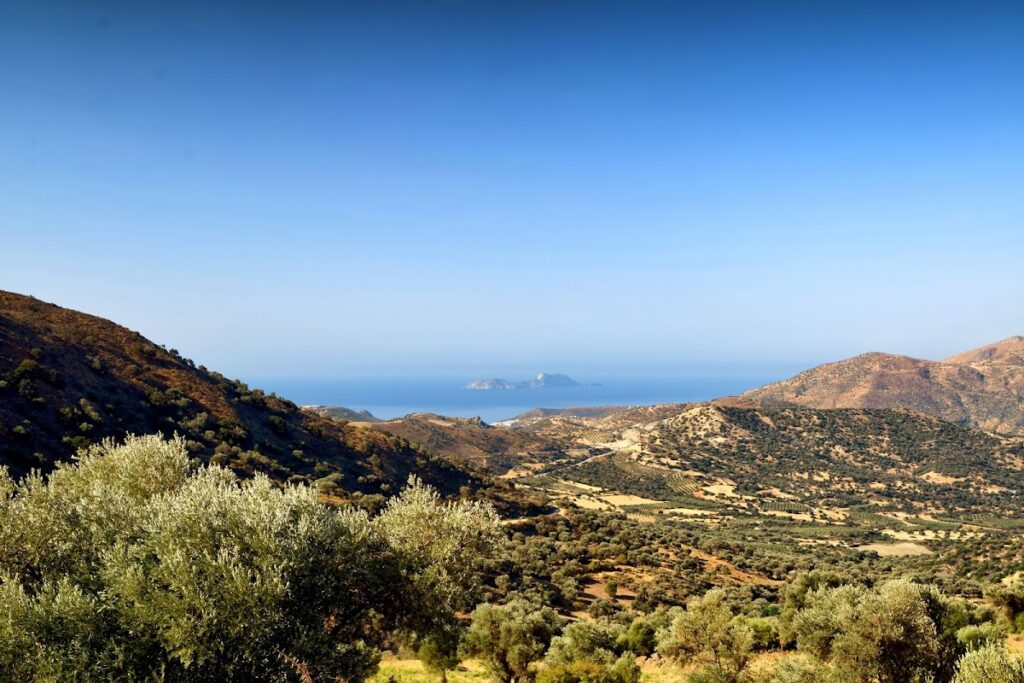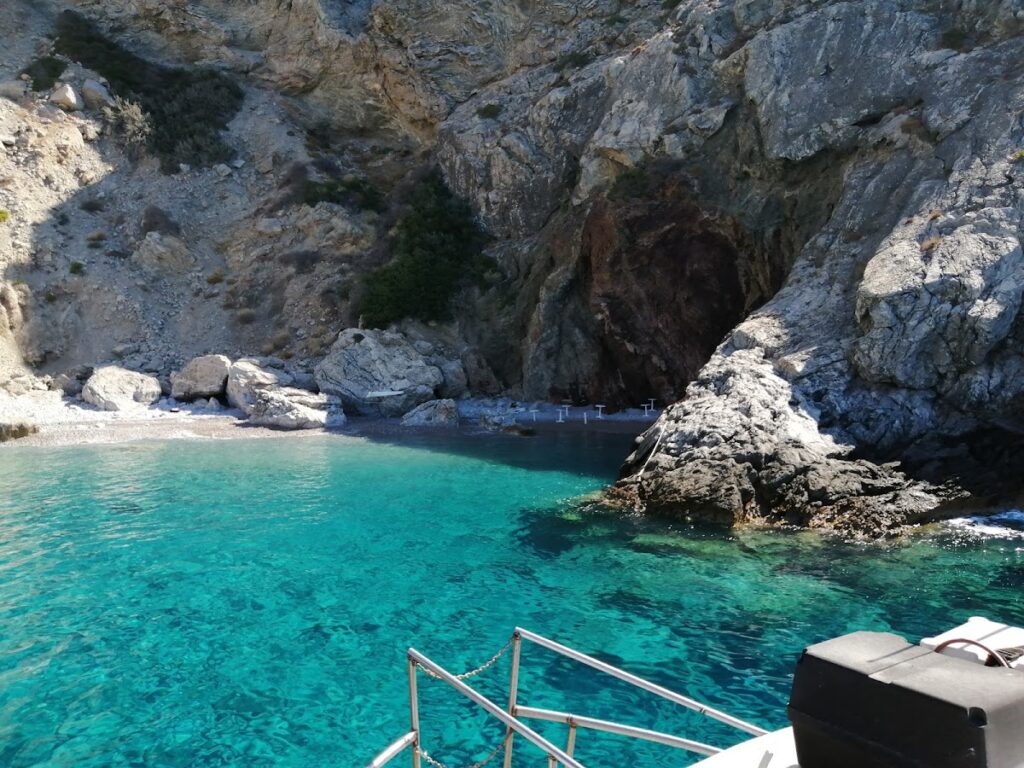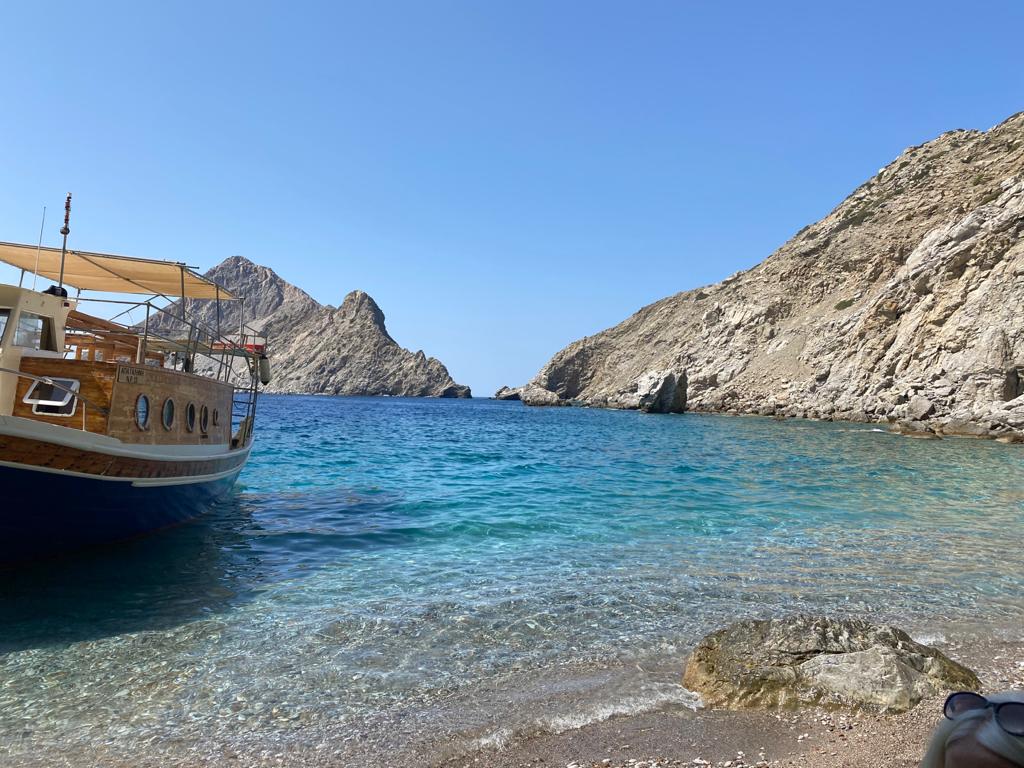Beaches near Agia Galini, in Rethymno region
Here is list of closest beaches to Agia Galini
- 470 m
- Agia Galini beach
- Fine Pebbles, Pebbles
- Normal
- Blue
Agia Galini, a well-loved seaside resort in the southern part of the Rethymnon prefecture, is located near the Amarianos or Platys River mouth. It’s 61km south of Rethymno city and 68km southwest of Heraklion. This quaint town flourishes with activity in the summer and offers all necessary tourist facilities. The stunning green beaches, the fascinating caves in the west, the legends of Icarus and Daedalus, the hippie memories and the peaceful sea, make this village a popular spot for numerous visitors.
Starting east of the port, a long beach extends to Kokkinos Pirgos. The sea here is typically serene. The beach section near the port is well-facilitated and features fine pebbles and chilled water, due to the nearby Platys or Amarianos River, located 200m east of the port. Near the river, remnants of an ancient Artemis temple have been discovered.
Crossing the river via a metal bridge leads to the second beach, which stretches another 1km to the east. This beach, with small pebbles and less organization, is adjacent to the Agia Galini camping site. As you progress eastwards, the beach becomes narrower and more rugged. A 1.5-2 hour walk will take you to Kokkinos Pirgos. This beach, inaccessible by road and favored by nudists, is completely unorganized so be sure to bring food, water, and umbrellas.
On the beach’s west end, beneath a hill with houses, there’s a small network of tunnels from World War II. You can explore these to reach the hilltop.

- 2.9 km
- Agios Georgios
- Fine Pebbles, Pebbles, Rocks in places
- Normal
- Blue
Situated 3km west of Agia Galini, 69km southwest of Heraklion, and 60km south of Rethymno, you’ll find the tranquil valley of Agios Georgios. This spot is home to two small bays, each boasting beautiful pebbly beaches separated by a rocky shore. The weather is often mild, making these beaches perfect for year-round swimming.
The area remains relatively undeveloped, but on the eastern beach, known as Lichnistis, you’ll find a handful of rooms, a tavern, and some umbrellas for shade. A visit to Agios Georgios offers the chance to explore the rugged Cretan countryside and take a stroll to the historic Monastery of St. George, located 500m to the north. The church’s sloping walls show signs of age and soil sedimentation, and inside, you’ll find ancient frescoes.
For those seeking solitude, the western beach, Kolimbistiri, or “swimming area”, is the ideal location. Here, you can swim in peace, and the seabed offers excellent snorkelling opportunities. To reach Agios Georgios’ beaches, take the asphalt-paved road from Agia Galini to Agios Pavlos, or hop on a boat from Agia Galini.
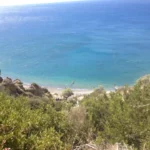
- 5.5 km
- Kokkinos Pirgos beach
- Fine Pebbles, Rocks in places
- Normal
- Blue
Kokkinos Pirgos, also known as Red Tower, resides 67km west of Heraklion, near the town of Tymbaki. Its name is derived from a tower constructed from red soil, situated at the mouth of the Geropotamos river. As the coastal village of Timbaki’s main port and a hotspot for tourism, Kokkinos Pirgos is home to numerous hotels, dining establishments, and cafes. The area’s climate is typically warm, enabling locals to cultivate fresh vegetables in greenhouses.
The village boasts a lengthy sandy beach that stretches southeast towards Kommos for several kilometres. This expansive beach is a nesting ground for loggerhead sea turtles (Carretta Carretta) during the summer months. Conservation organizations such as Archelon work to protect these sea turtles and their nests. The beach, which is susceptible to western winds, begins at Timbaki’s military airport wire fence on the east and extends to Agia Galini on the west.
The beach’s eastern portion, stretching from the port to the airport, is known as Katalyki. This well-equipped beach features amenities such as umbrellas, sunbeds, lifeguards, and water sports. A coastal road lined with cafes and restaurants runs alongside the beach, making it a popular spot for refreshments. East of Katalyki lies a sizable marsh, a key wetland in the Mesara plain, which is irrigated by the Geropotamos River.
The beach area west of the harbor is known as Makrimaliana. The beach near Kokkinos Pirgos is relatively broad, but as it extends towards Agia Galini, gravel massifs encroach upon it, narrowing the beach and in some places, eliminating it during high tide. This unorganized, remote beach may not be extraordinary, but the wind and sea-carved rock formations that flank it are certainly impressive.
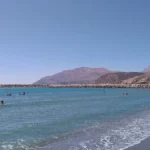
- 8.5 km
- Louros beaches
- Pebbles, Rocks in places
- Normal
- Blue
Louros, nestled between the settlements of Agios Georgios and Agios Pavlos, is characterized by its rocky terrain and a collection of small, pebbly beaches. A scenic coastal road provides stunning views of the two Paximadia islets. Heading west from Agios Georgios, travelers will encounter the quaint beaches of Armenopetra, named after a solitary boulder found in the sea. These beaches offer excellent opportunities for snorkeling and spearfishing.
Two kilometers before reaching Agios Pavlos, another beach, either known as Agios Markos or Ligiolakos, is found across from the rock known locally as Prasonisi. The waters here are typically tranquil, making it a favorite spot for local families from Melambes. The seabed is also a great place for snorkeling and spearfishing. Further east of Prasonisi, more similar beaches can be found, usually accessed on foot.
The next beach, Aniforas or Vigdolidi, is difficult to reach due to private property blocking the path. The beach is situated near a striking rocky cape, and while the beach itself is unremarkable, the towering rock formation provides excellent photo opportunities.
The final beach, located 500m east of Agios Pavlos, is positioned at the mouth of a stream. Ancient Cretan date palm trees, known as Theophrastus, line the banks of the stream, giving the pebbly beach its name – Finikidia.

- 10.0 km
- Kalamaki beach - Heraklion
- Fine Pebbles, Rocks in places
- Normal
- Blue
Kalamaki, a quaint seaside hamlet, is nestled between Matala and Kokkinos Pirgos, 65km southwest of Heraklion. The beach, a 2.5km stretch of the vast Messara Bay coastline, graces the village’s front. Its sandy shore is kissed by the sea, which conceals a slick, flat rock bed beneath its surface. It features large waves, usually stirred by northwest winds, making beach access challenging at times due to the rocky seabed.
The village-facing part of the beach is well-equipped with sunbeds, umbrellas, eateries, accommodation, a lifeguard, playground, and water sports. For a more isolated experience, head southeast towards Kommos beach, a favorite among nudists.
To the north, you’ll find Afratias and the Pahia Ammos beach, which features patches of rocks. Devoid of amenities, the beach does boast a small park used for hosting cultural events like concerts during summer months.
Further north lies the Timbaki military airport, now serving as a resort for Greek Air Force staff. Although the beachfront is accessible, trespassing beyond the fence is prohibited and could lead to arrest. Sometimes, parachuters and skydivers can be spotted descending from small aircraft, courtesy of a local club based at the airport. In 2008, a small plane crashed into the Kalamaki sea, with the pilot miraculously surviving the ordeal. The Tymbaki airport holds ecological significance for the Mesara plains as it’s intersected by the Geropotamos River, which flows out to the beach. This river, the area’s largest, serves as a sanctuary for hundreds of rare birds across its numerous ponds.
The sandy coast of Messara Bay is a protected breeding ground for the loggerhead sea turtle. To prevent nest destruction and avoid frightening these creatures, it’s best not to roam the beach’s darker areas during summer nights.
Although Kalamaki doesn’t boast a significant history due to its relatively new establishment, it’s a popular seaside resort for Kamilari locals. Some believe it once served as a small harbor for Phaestus or Gortys in ancient times, though no concrete evidence supports this claim.
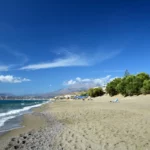
- 11.3 km
- Agios Pavlos beach
- Rocks in places, Sand
- Normal
- Blue
Agios Pavlos, a quaint seaside village, lies 58km south of Rethymnon city and to the west of Agia Galini, situated conveniently close to the extremity of Cape Melissa. The village, mainly owned by locals from nearby Sachtouria, can be accessed via a scenic drive from there. This hidden gem nestled in a shielded bay is perfect for serene family getaways.
A breathtakingly beautiful beach with emerald deep waters and an impressive rocky seabed characterizes the bay. Several accommodations and taverns dot the area near the beach, offering various amenities including sunbeds, umbrellas, and pedal boats. An intriguing point of interest here is the quaint church of Saint Paul perched above the beach. Legend has it that Saint Paul resided here during his voyage to Rome – a folklore shared by other regions in Crete such as Kali Limenes and Selouda.
The village’s beach is certainly picturesque, yet some visitors choose to lodge and dine in Agios Pavlos, preferring to swim in the nearby stunning beach known for its enormous sandhills. This beach, referred to as Akoumiani Gialia or Melissa, lies beyond the western rim of the Agios Pavlos bay. Although it’s often wavy, it’s considered one of Rethymno prefecture’s finest beaches, accessible via a pathway originating from Agios Pavlos.
The vibrantly coloured geological rock folds at the Apoplystra location, situated between Agios Pavlos village and Melissa’s Sandhills, are incredibly striking and have been recommended for inclusion in Greece’s Natural Monuments list.

- 11.4 km
- Komos beach
- Sand
- Normal
- Blue
Situated 66km southwest of Heraklion, Kommos (or Komos) lies a mere 2km north of Matala and in close proximity to Pitsidia village. It stands as the southernmost and remotest section of the extensive beachfront of Messara Bay. Once serving as the port of Phaestus, the remnants of the ancient port of Kommos can still be observed on the beach. It can be reached by driving towards Matala and following a sign to Kommos near Pitsidia.
The entire beachfront of Messara is exposed to the prevalent westerly winds. Visitors should exercise caution as the seabed can be rocky in certain areas. The beach also serves as a nesting ground for the protected loggerhead sea turtles (Caretta caretta) between the months of May and September.
Potamos or Potamoserma, the northern section of Kommos, is a popular spot among naturists, dating back to when hippies frequented the area. The location is dotted with sparse tamarisk trees and devoid of buildings due to its protected archaeological status, restricting construction. Next to the archaeological site in the south, there is a developed beach equipped with amenities such as umbrellas, sun beds, a toilet, showers, a canteen and a lifeguard. Surrounding sand dunes are home to white sand lilies that mark the end of summer. Nearby Kalamaki or Pitsidia and Matala offer options for accommodation and dining.
The sight of Paximadia islets during sunset is breathtaking. A large rock, known locally as Volakas, stands 300m out at sea, opposite the archaeological site. According to local lore, this rock is the tip of the boulder that the blinded Cyclops Polyphemus hurled at Odysseus’ ship to prevent his escape, following Odysseus and his crew’s escape from Polyphemus’ cave.
Kommos, the ancient port of Phaestus, was established around 200BC. However, it was subsequently destroyed by an earthquake and then rebuilt at the same location. The archaeological site of Komos, not open to the public, houses a Minoan harbour, public buildings, warehouses, oil presses, shipyards and a large courtyard. Archaeologists have uncovered a small temple, constructed on the ruins of an older one.
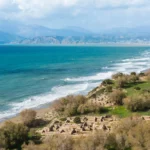
- 11.6 km
- Melissa Cape Sandhills
- Rocks in places, Sand
- Deep
- Blue
Among the premier beaches in central Crete, the Melissa Cape Sandhills shine bright. Situated near Agios Pavlos, at the southern tip of the expansive Akoumiani Gialia coastline, this stunning location is approximately 55km south of Rethymno city. It’s framed by the beautiful Cape Melissa to the south, the Akoumianos river, and the Triopetra beach to the north. The deep sea here beckons swimmers, and the area’s secluded nature often leads to a variety of beachwear or a lack thereof. Locally, the beach is also known as Alatsogremi or “salt cliffs”.
The Melissa Cape Sandhills, arguably the most scenic beach in the Rethymnon prefecture, boast massive sand dunes nestled amidst a majestic, untouched landscape. A few scattered umbrellas offer shade, although natural refuge can be found in the rocky caves mid-beach. Despite its generous expanse, the beach rarely feels crowded, even allowing for nude bathing during peak season. A rich seabed makes it a snorkelling hotspot, although visitors should be aware of the frequent large waves due to western winds. The water temperature remains warm year-round, hardly dropping below 15 degrees Celsius, perfect for winter swims.
The area is famed for its breathtaking sunsets, providing a serene backdrop for a thriving yoga and Tai Chi club that boasts world-class trainers. The best view of the sunset can be found atop Thronos peak, overlooking the beach from towering cliffs. To reach it, follow the dirt track next to the junction of Agios Pavlos – Sactouria and Triopetra-Agios Pavlos roads, then hike to the cliff edge. This vantage point offers sweeping views of Paximadia islets, Gavdos Island, and the White Mountains.
Access to the Sandhills is straightforward. Head west from Triopetra harbour (Stomio) for about 500m until you reach the beach on your right, with the Akoumianos river below. Park your vehicle here and make your way down to the beach through the valley near the river. Alternatively, you can park in Agios Pavlos and take the short 5 to 10-minute trail behind the western edge of the Agios Pavlos beach, which descends down a steep sandy slope.
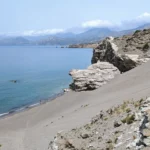
- 12.6 km
- Triopetra beach
- Fine Pebbles, Pebbles, Sand
- Normal
- Blue
Triopetra beach, nestled at the base of Mount Siderotas and 52km south of Rethymno, can be reached via paved roads leading from either Akoumia or Sachtouria. Part of the extensive Akoumiani Gialia beachfront, Triopetra got its name as a historical winter refuge for the inhabitants of Akoumia, who built small huts near their olive groves. Presently, most land and hotels in the area are owned by descendants of these Akoumia residents.
Triopetra boasts two distinct beaches, separated by a petite peninsula. The peninsula’s defining feature is the three spectacular rocks jutting out from the sea, giving Triopetra its name, which translates to “Three Rocks”.
The first beach, Small Triopetra or Koumado, resides in an enclosed bay lined with sand and rock to the south of the three rocks. Here, the Akoumianos river meanders into the sea, forming a natural boundary between Triopetra and the enchanting Agios Pavlos Sandhills at Cape Melissa. Small Triopetra hosts a handful of taverns and rooms, with umbrellas available for sun-seekers. Additionally, the southeast edge of the beach is home to a small harbour, known as Stomio or “mouth”, named after the river’s mouth meeting the sea. Just 1km northeast of the beach, the awe-inspiring chapel of Prophet Elias stands on a high hill, commanding an impressive view over Akoumiani Gialia.
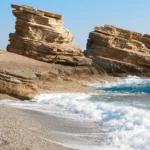
- 12.7 km
- Paximadia islets
- Fine Pebbles, Pebbles
- Deep
- Deep blue
The Paximadia Islands are twin uninhabited islets located off the Gulf of Messara, situated approximately 12km south of Agia Galini. At a distance, they appear as one due to their proximity, but on closer inspection, they are separated by a slender channel known as Bogazi. The locals often refer to these islands as the “Elephant” due to their resemblance to a reclining elephant when viewed from the Messara plane. The collective length of these islets is roughly 3km.
Contrary to common belief, the Paximadia Islands are not merely large barren rocks in the sea, but they also harbor beaches. The smaller of the two islands, the East Paximada, boasts four exquisite tiny beaches with clear waters and picturesque pebbles. These islands are accessible via tour boats departing from Kokkinos Pirgos and Agia Galini.
The West Paximadi, though lesser-known, possesses its own unique charm. It houses a beautiful beach named Varkaki. Starting from Varkaki, the western edge of the island stretches out to the cape of Sakouleva. Sakouleva is a striking spot, often wavy and adorned with a plethora of vibrant colors due to the presence of various rock types on Paximadia. The entire Big Paximadi is a wild landscape with steep cliffs culminating in a pyramid peak, with Sakouleva being the most awe-inspiring spot. A boat ride allows you to reach the edge of Sakouleva and its imposing rock formation. The view extends to the cave of Tzigounas, the largest among the numerous caves on Paximadia.
Historically, these minor islands were under the rule of Phaestos, a powerful and affluent city. They were then known as the Islets of Dionysoi, named after Dionysos, the god of wine. Local lore suggests that the goddess Artemis and nymph Vritomartis hunted here frequently. They were also called Litoai or Letoae, after the goddess Lito, mother of Apollo and Artemis, who was worshipped in Phaestos. One legend even implies that Lito gave birth to Apollo and Artemis on these islands. Presently, they are known as Paximadia, as their form resembles Paximadia, a traditional dry bread named after the Hellenistic cook, Paximus.

No results available
Reset





